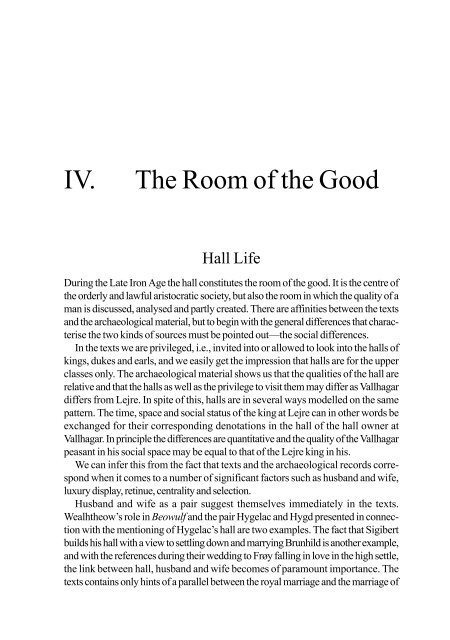Beowulf - Institutionen för arkeologi och antik historia
Beowulf - Institutionen för arkeologi och antik historia
Beowulf - Institutionen för arkeologi och antik historia
Create successful ePaper yourself
Turn your PDF publications into a flip-book with our unique Google optimized e-Paper software.
IV. The Room of the Good<br />
Hall Life<br />
During the Late Iron Age the hall constitutes the room of the good. It is the centre of<br />
the orderly and lawful aristocratic society, but also the room in which the quality of a<br />
man is discussed, analysed and partly created. There are affinities between the texts<br />
and the archaeological material, but to begin with the general differences that characterise<br />
the two kinds of sources must be pointed out—the social differences.<br />
In the texts we are privileged, i.e., invited into or allowed to look into the halls of<br />
kings, dukes and earls, and we easily get the impression that halls are for the upper<br />
classes only. The archaeological material shows us that the qualities of the hall are<br />
relative and that the halls as well as the privilege to visit them may differ as Vallhagar<br />
differs from Lejre. In spite of this, halls are in several ways modelled on the same<br />
pattern. The time, space and social status of the king at Lejre can in other words be<br />
exchanged for their corresponding denotations in the hall of the hall owner at<br />
Vallhagar. In principle the differences are quantitative and the quality of the Vallhagar<br />
peasant in his social space may be equal to that of the Lejre king in his.<br />
We can infer this from the fact that texts and the archaeological records correspond<br />
when it comes to a number of significant factors such as husband and wife,<br />
luxury display, retinue, centrality and selection.<br />
Husband and wife as a pair suggest themselves immediately in the texts.<br />
Wealhtheow’s role in <strong>Beowulf</strong> and the pair Hygelac and Hygd presented in connection<br />
with the mentioning of Hygelac’s hall are two examples. The fact that Sigibert<br />
builds his hall with a view to settling down and marrying Brunhild is another example,<br />
and with the references during their wedding to Frøy falling in love in the high settle,<br />
the link between hall, husband and wife becomes of paramount importance. The<br />
texts contains only hints of a parallel between the royal marriage and the marriage of<br />
167








